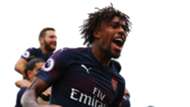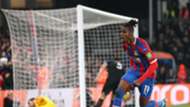
The Nigeria international moved to Merseyside last summer, but is little more than a squad player under Carlo Ancelotti
The ideal transfer, as a concept, would see all three parties involved – player (representative included), selling club, buying club – perfectly satisfied with their lot at the end of negotiations.
In the strictest terms, this scenario is almost impossible to come by; the very nature of economic activity makes that apparent. However, two out of three is an acceptable enough compromise. One out of three though, and one begins to wonder…
Take Alex Iwobi, for instance.
The 23-year-old, who came through the ranks at Arsenal and had been a valuable squad player for four seasons, joined Everton in the summer for a fee rising to £35 million. It was immediately a transfer that sent alarm bells ringing.
Of the three parties involved, only the North London club could be said to be have been pleased with the business they had been able to do. Having made a number of purchases: a club-record acquisition of Nicolas Pepe from Lille and Kieran Tierney from Celtic among others, the Gunners were eager to recoup some money to offset their splurge, and so considered a player of Iwobi’s status expendable.

Iwobi himself, a player who joined Arsenal at the age of eight, admitted to Soccer Saturday he had been “very comfortable” at the Emirates and “didn’t think about any move” before receiving the call from his agent while on break following the 2019 Africa Cup of Nations.
For their part, Everton had been in the market for a left-winger, and had specifically targeted Crystal Palace’s Wilfried Zaha, who was keen to move to Goodison Park.
Only on transfer deadline day, when it became clear the Eagles would rebuff any further approaches, did they explore the possibility to signing Iwobi instead.
So, from the outset, it was clear there was going to have to be some making do.
While Iwobi is a conscientious enough professional that he would be willing to fit within the ethos of a nominally smaller club, there is a significant difference in direct goal-threat and output between him and a player like Zaha, similarities in their ball-carrying aside.

It started pretty well for the Nigeria international on Merseyside; he scored two goals in his first two starts for Everton, high-scoring wins over Lincoln City and Wolverhampton Wanderers in the League Cup and Premier League respectively, and then laid on a typically understated assist in the following round of the cup as Everton saw off Sheffield Wednesday.
Crucially, he seemed to strike up an understanding with Lucas Digne on the overlap, in much the same way he had the season before with Sead Kolasinac.
However, as Marco Silva’s stewardship of Everton devolved into disaster, a player acquired at significant expense from Arsenal became an easy lightning rod for fan criticism and frustration.
It did not help that Iwobi is a player doomed to be misunderstood—much of what he brings to the team is unquantifiable, and he was repeatedly shunted out wide, with Gylfi Sigurdsson – an even less involved player, but capable of the odd howitzer from distance – preferred centrally.
Following a humbling derby defeat at the hands of Liverpool in mid-December, the Everton hierarchy decided they had seen enough and severed ties with Silva.

Carlo Ancelotti would replace him in a sensational swoop two weeks later, but in the intervening period, Duncan Ferguson took temporary charge, banking five points from matches against Chelsea, Manchester United and Arsenal.
Iwobi started all three matches, but injured his hamstring just 11 minutes in against his former club.
The timing was desperately unfortunate; an opportunity to make a favourable first impression on the watching Ancelotti snatched away in cruel fashion.
By the time Iwobi returned to the matchday squad, he had lost seven weeks of active playing time. In that period, the new regime had decided on a settled XI, and had won three and drawn two of its first six matches. There was not going to be a rush to re-integrate him.
As such, it now seems he is playing catch-up at Goodison Park. So far, he is in the same role as he was at Arsenal: squad player. In many respects, it is a step-down.
However, there is enough to suggest there might be some hope for him when football in England does eventually resume.

Yet again, it is Sigurdsson who has been preferred on the left of Ancelotti’s preferred 4-4-2, with the right side of midfield featuring a more direct attacker. However, aside his aptitude in set-piece situations, the Icelandic midfielder’s expected assists (xA) numbers per 90 in open play are weaker than Iwobi’s (0.08 to 0.11), as are his xG per 90 and xG per shot per 90 (0.12 and 0.09 respectively, compared to 0.17 and 0.13) – per understat.com.
Take out dead balls, and Iwobi actually offers Everton more in terms of attacking output.
As things stand, however, the most he can do is keep his head down and continue to work, seizing what sporadic opportunities come his way.
However, much as it is clear he has not quite gotten a fair crack under the brow-arching Italian, it is difficult to reckon with Iwobi’s first season at Goodison as anything more than a disappointment.

Be the first to comment